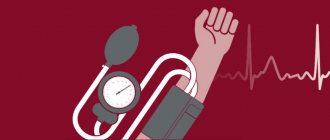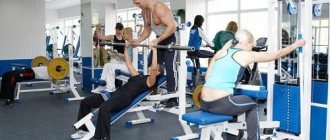The main advantages of running during VSD are not only the normalization of blood pressure, but also the stabilization of health in general; this is getting rid of VSD; this is self-affirmation and a kind of victory over oneself. How nice it is that, although you have grown older in years, you have not aged physically. You are not registered with the notorious dispensary, you do not visit a doctor and you lead a completely natural life, without bothering your household and work colleagues with your complaints.
Running during VSD is a pulsating vital energy that makes all organs and systems of the body work harmoniously. Running normalizes metabolism, makes blood vessels elastic, and therefore blood pressure is always good. It harmonizes the functioning of the gastrointestinal tract and genitourinary system, and therefore those who run are always in perfect shape, young not only in body, but also in soul. Let's treat VSD by running! To start fighting a disease with the help of running, you need to decide what this running is for and whether you will do it seriously. After all, a lot of books and articles have been written about running, but still there are only a few people who run, and even fewer who run correctly, according to a certain method. Some people run without even knowing where and how to count their pulse, while others, literally after a week or two of training, are trying to run a very long distance, and run quickly, not at their natural pace. Others, due to bad weather, sit out in a warm apartment and only go for a run when the sun appears in the sky. The result is “breakdowns,” dissatisfaction, and even worse – exacerbation of existing diseases, or acute heart failure may occur. Therefore, before you start running, you need to clearly define your own capabilities. It won't do any good if you run incorrectly. In particular, this applies to people prone to high blood pressure.
To begin with, it still makes sense to learn a little about self-control, at least about its elementary tests. We also need to understand the indications for running. It’s also a good idea to determine your psychological state. For example, if a person has been suffering from many diseases for many years, he is impressionable and can react painfully to the mocking remarks of random ill-mannered passers-by, he should start running in special conditions.
Symptoms of VSD
There are several different types of dystonia, and symptoms will vary for everyone.
With cardiac dystonia, prolonged heart pain, increased heart rate, and increased blood pressure are observed.
The tachycardial type of dystonia is accompanied by a gradual increase in heart rate, increased pressure, and a feeling of vibration in the temples.
The hypertensive type is similar to an attack of hypertension, but the pressure does not exceed 170/96 mm Hg.
The visceral type is associated with problems in the gastrointestinal tract. Constipation, flatulence or diarrhea are observed.
The hypotonic type of the disease is signaled by a decrease in pressure to 90/60 mm Hg, in some cases lower. Weakness appears, limbs become colder, and sweating may increase.
With the asthenic type, performance is greatly reduced, while the temperature rises to subfebrile levels, and the hands begin to tremble.
The respiratory type is associated with respiratory problems. Pressing pain in the chest area, yawning, and dry cough appear. It becomes more difficult for the patient to breathe.
The mixed type includes symptoms of different types of VSD. Adolescent dystonia also belongs to this type. It is not dangerous and often goes away on its own and is associated with hormonal changes in the body during puberty.
In the vast majority of cases, this diagnosis provokes osteochondrosis. Why this disease appeared - only a doctor can answer based on a detailed examination of the patient. Self-medication in this case takes away your precious time, while the disease can develop into more serious forms.
What sports are allowed for VSD?
Is it possible for you to play sports if you have VSD? Only a doctor can tell you for sure. His decision depends on the type of disease, its course, and your well-being.
Dystonia is dangerous because it causes a deficiency of oxygen and nutrients in the human body.
Basically, with this diagnosis, it is recommended to choose the following types of physical activity:
- Step aerobics. Only on condition that the platform is installed as low as possible.
- Fitball exercises.
- Stretching, high jumping. These exercises train the vestibular apparatus well and stimulate the circulatory system.
- Eastern martial arts (except sparring).
- Swimming and water aerobics. Positively affect the functioning of the heart.
- Game sports – tennis, volleyball.
- Cardio equipment - treadmill, bicycle, elliptical.
Choosing a sport that is compatible with dystonia is not difficult. Even power loads are allowed, but only with light weight. If you want to exercise with a barbell, then the set of exercises needs to be compiled especially carefully. Strength training should be well mixed with swimming or stretching. At the same time, you need to monitor your condition and if you feel unwell, you should immediately stop exercising and rest.
Training time needs to be increased gradually so that the body has time to adapt to new working conditions. During the first lesson, you cannot do one approach for more than 12 minutes. Subsequently, the duration of the exercise increases by 2-5 minutes, depending on your condition.
Choosing a direction
Is it possible to play sports with VSD? Of course, you just need to choose a direction that is safe for the patient. There are different types of physical activities, but not all of them are suitable for VSD.
In athletics, you can use all directions, except for putting weights: shot, hammer, discus, and it is also necessary to exclude pole vaulting. Running will be the best and unique thing for the whole body. When running, more than 80% of the body's muscles are used, all body systems are included in the work, supplying oxygen to all internal organs. For effective training, you need to gradually raise the bar and increase the load, create a regular schedule and follow all the rules. The heart will gradually start working, coping with a large volume of blood, so the person will no longer feel pain in the heart area and disturbing thoughts will not visit him. The brain will feel much better, since excess oxygen and increased blood supply will speed up thought processes, help get rid of depression and cope with stress more easily.
Cycling and horse riding also have no warnings for VSD; the main thing here is smooth movements without jerks and a measured rhythm. In winter, these activities can be replaced by skiing or skating.
There are restrictions for martial arts; these game sports can only be allowed without participation in sparring and, especially, competitions. One can learn this art from a technical point of view. The same applies to acrobatics, gymnastics and figure skating, because they are quite traumatic and can cause irreparable harm, especially with brain injuries. Alternatively, you can use aerobics or fitness classes. It is these directions that will help bring the body into ideal shape, give strength to the body and give yourself a good mood, resisting stress.
You can use water aerobics or swimming for VSD. Exercises in water relieve stress from the spine and joints, strengthen the cardiac system and respiratory organs.
To strengthen the vestibular system, you can try exercises on a fitball, just remember to measure the exercises. With this item it is convenient to do stretching, which is beneficial for any body.
In summer, in good weather, you can have fun with football, volleyball, tennis, and badminton. These games, in addition to providing a positive charge, will help improve your health.
Vegetative-vascular dystonia is a problem that does not tolerate inaction. You need to take your health seriously and reconsider your current lifestyle. Start moving more, engage in safe exercise, and start eating well. Then you will not be afraid of any neuroses or mental disorders.
Doctors' opinions on whether VSD and sports are compatible are divided. This was due to complaints from patients who did not want to exert themselves that exercise made them feel bad.
There is a reasonable opinion that serious deterioration in health is caused by immobilization.
This is harmful to physical health and emotional health. The stress that the body experiences from physical inactivity provokes attacks of dystonia, so the only solution is to include physical activity in a suitable area in the daily routine.
Contraindications for VSD
The combination of vegetative-vascular dystonia and any sport has its limitations. In order not to stimulate the development of the disease, you should follow some recommendations:
- You cannot perform exercises in which the head is lower than the chest level, or with the body positioned “upside down”.
- Deadlifts are prohibited. It is dangerous for the vascular system.
- Do not allow your body to overheat. This is too much stress on the blood vessels.
- Monitor your well-being. If you feel unwell, it is better to stop training.
- There is no need to force yourself to train because “that’s how it’s supposed to be.” Playing sports should bring you joy and satisfaction.
Ignoring alarming symptoms and overexertion of any kind (physical, mental) can provoke a vegetative crisis. This consequence has a bad effect on the heart and other organs of the vascular system.
How to plan a training regimen for a patient with VSD?
Classes begin with stretching, smooth movements, controlling breathing and heart rate. First, the exercises are performed for 7-12 minutes. When training, you should avoid positions with your legs raised up. It is important to combine aerobic and anaerobic exercise to engage all muscle groups.
There is no need to allow yourself to become exhausted; only a feeling of slight fatigue is possible . You should not exercise in a stuffy room; if you feel unwell, it is recommended to temporarily stop training.
Breathing requirements when playing sports:
- smooth inhalation through the nose and exhalation through the mouth;
- breathe with your diaphragm;
- The breathing rhythm must correspond to the movements performed.
How to behave in the gym
Having a diagnosis of VSD requires great caution when exercising with weights. It should be remembered that for problems with blood vessels, only light and medium weights can be used. Endurance tests and heavy sports like kettlebells can be detrimental.
During training, you need to carefully monitor your breathing and provide the body with sufficient time to rest. It is advisable to visit the gym in the company of a friend, relative, or hire a personal trainer. The latter needs to tell you about your diagnosis in advance so that he can choose a suitable training regimen for you.
People often come to the gym with the goal of “building” themselves a beautiful body. Bodybuilding has a lot of different areas, among which you can find something suitable for yourself. VSD as a disease includes several degrees of severity. Each of them has its own characteristics in terms of training:
- I and II degrees. The most harmless variants of the development of the disease. The main condition for such people is to warm up well before starting classes.
- III degree. In this case, you should train in a balanced manner, giving the body short breaks between approaches, regardless of how you feel. It is important to drink enough water. And such weight loss aids as sauna suits and shapewear are strictly prohibited.
- IV degree. The heaviest of all. All of the above conditions must be met. It would be better to have the training supervised by a professional fitness trainer. Static loads and light dynamic pumping of specific muscle groups are considered the safest for such people. Before visiting the gym, you should consult your doctor.
Basic recommendations
Sport is an auxiliary method of treating VSD, which increases the effectiveness of therapy. Before selecting a set of exercises, remember these simple recommendations:
- Physical activity should increase motor activity, but not cause sudden changes in body position.
- Don't train as hard as you can. Overload is fraught with deterioration in health.
- Constant monitoring of pulse and blood pressure after another workout causes unnecessary anxiety, which leads to an exacerbation of symptoms.
- Exercise in comfortable clothes and preferably in the fresh air.
- Combine different types of loads to activate all muscle groups.
Sports activities accompanied by your favorite music increase the productivity of your workout and improve your well-being.
In case of vegetative-vascular dystonia, vigorous sports are not recommended. Constant competition, anxiety and fear of losing provoke an exacerbation of the disease.
It is better to limit yourself to simple physical education. In this case, it will be possible to normalize the state of the cardiovascular and other systems while maintaining good health.
Exercising with VSD at home
Indoor sports for VSD are considered safer and more acceptable for people with this disease. This is a good way to take your mind off personal matters, while saving time and money on going to the gym.
The following set of exercises is considered the most effective:
- Circular movements with your hands. Stand straight with your feet shoulder-width apart to maintain balance. Alternately perform several rotations with your right and left hands. 5 sets of 15 seconds on each side will be enough.
- Palm squeezing. The starting position is the same. Place your hands in front of you and press them against each other for 20 seconds. The number of approaches is no more than 7.
- Head movements. Without changing your body position, place your hands on your hips. Slowly tilt your head left, right, back, forward. At least 5 repetitions.
- Circular movements of the shoulder girdle. Place your hands on your shoulders and rotate back and forth for 5 repetitions in each direction.
- Stretching. Here you have the right to choose any exercise you like. This can be a “frog” - straight and reverse, bending forward with straight legs.
- Static exercises. Place your hands on your waist, maintaining balance, lift one leg bent at the knee. When it becomes parallel to the floor, straighten and hold in this position for several seconds.
These exercises will be beneficial if you do them regularly and do not violate the technique. It is also necessary to carefully monitor breathing, since vegetative-vascular failure in the body provokes oxygen deficiency.
The condition of the vascular system will also be positively affected by regular walking, relaxation in the fresh air and light, non-energetic dance.
VSD and sports can be compatible with each other, but only if you approach training wisely and follow your doctor’s recommendations. In addition to balanced physical activity, the doctor may prescribe a course of drug therapy, diet and daily routine. The latest tips will be useful for everyone. Proper nutrition will help improve the functioning of important body systems, and proper rest will protect you from overexertion.
Features of training
Vegetative-vascular syndrome can become complicated if a person chooses a pace or load that is too tough for him. Inconsistency in the level of training can be expressed in tremors of the limbs, increased sweating, fluctuations in blood pressure, and heart rate. Any type of sport, if the load is calculated incorrectly, can increase the manifestations of VSD. With the correct prioritization of loads, a person will feel pleasure and positive emotions. Even fatigue after exercise will not strain and suppress a person’s nervous system, but on the contrary, it will relax the muscles and reduce stress levels.
In order to resort to strength training and not cause deterioration of the condition, it is necessary for the person involved in sports to follow the following recommendations:
- to eliminate imbalance of the ANS, in training, focus on local, single-joint exercises, in order to avoid additional stress for the body;
- do not make sudden movements or changes in body position, especially in cases of low blood pressure, because dizziness may occur and there is a possibility of injury;
- do not lower your head below your pelvis;
- do not hold your breath, the respiratory system should work smoothly;
- combine weights with light aerobic exercise;










